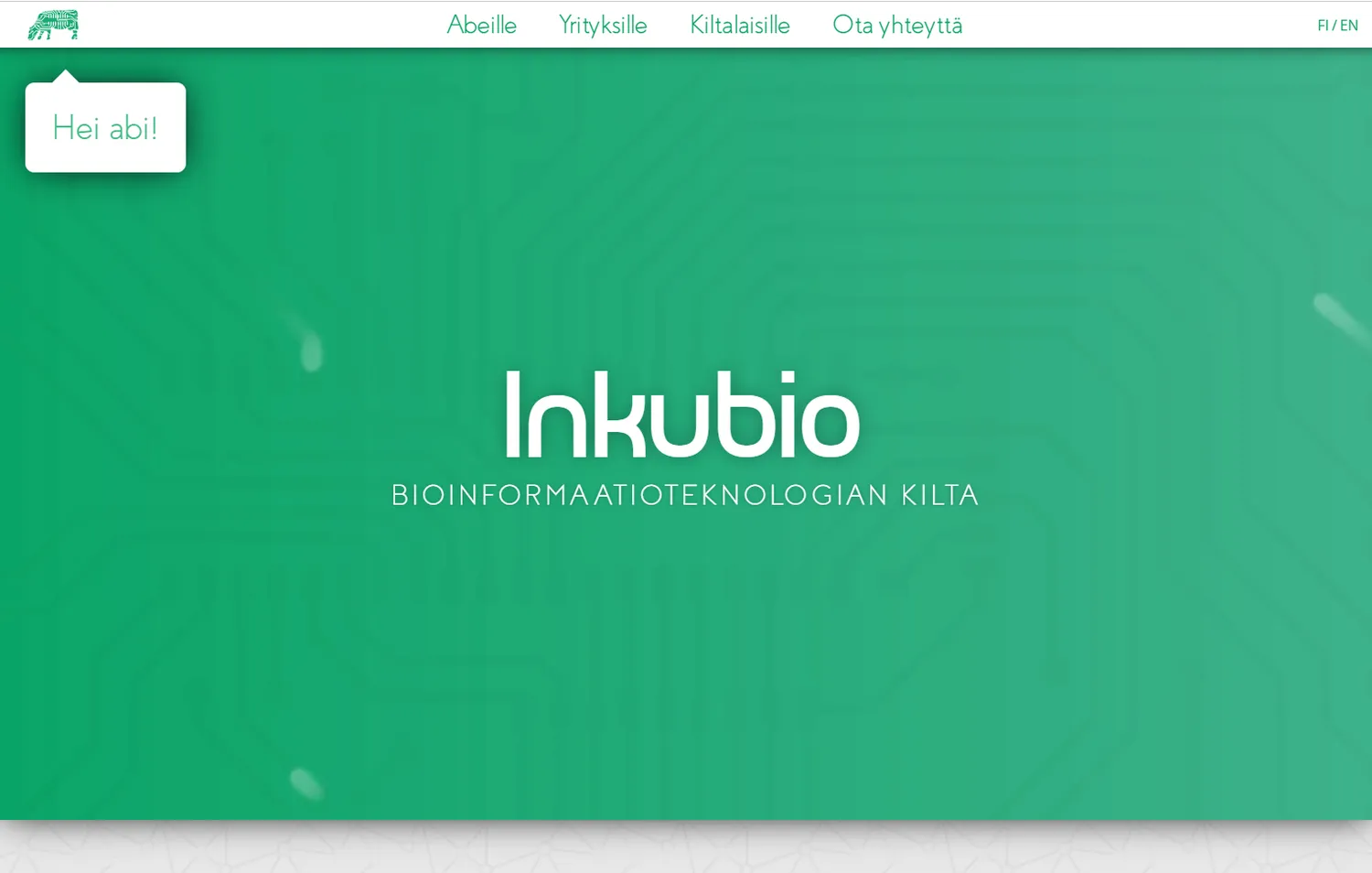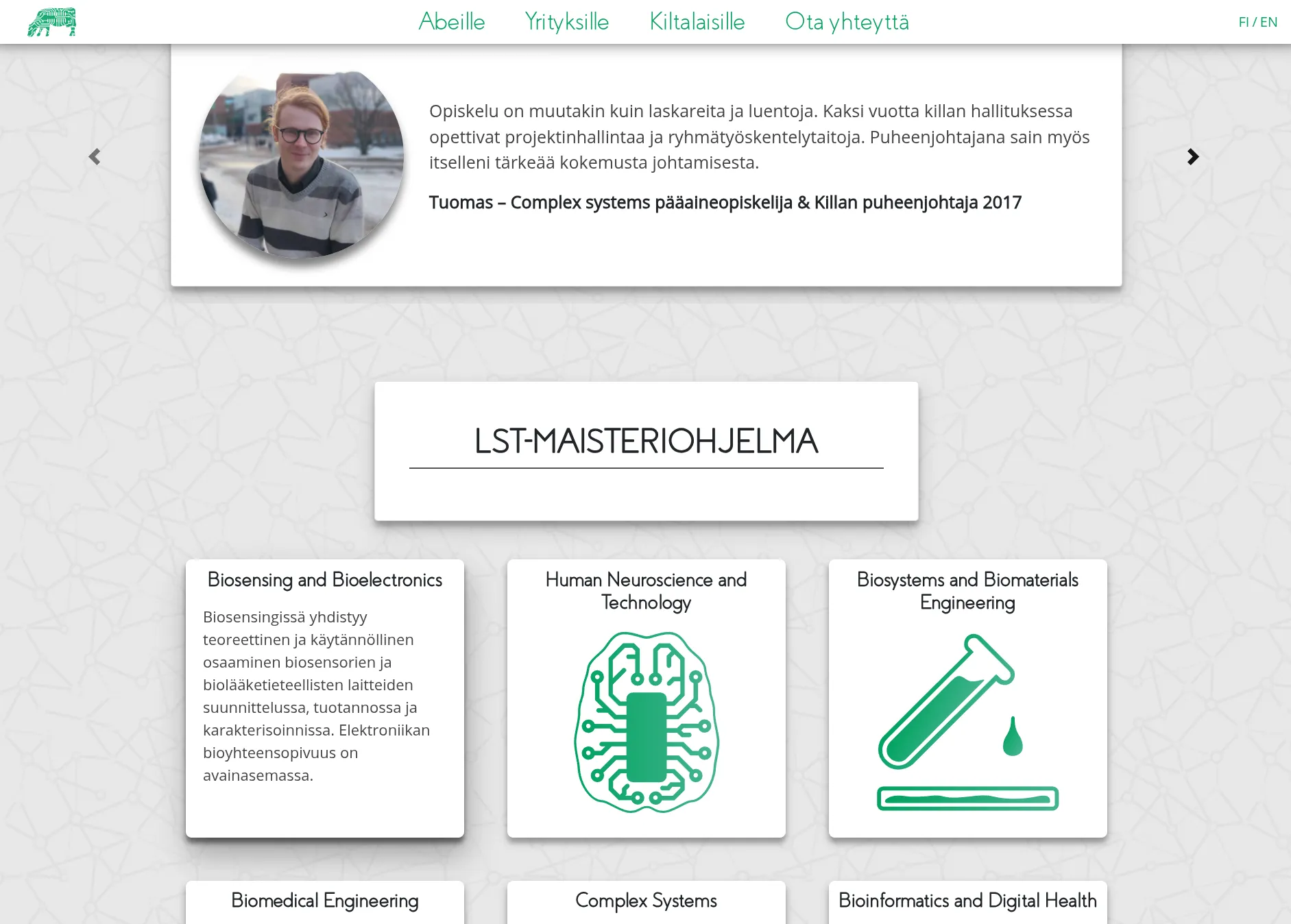inkubio.fi

In Aalto University, students from different technical majors organize in associations – guilds – and the association I considered home is Inkubio. Everything works via volunteering, including hosting a website about the guild, its board, officials, events, magazines, history, et cetera. As an aspiring programmer, the guild website was something I eanted to contribute to.
At that time the website was built with Drupal, and it was considered quite a headache. At our guild room, I occasionally heard the board member responsible for the site lamenting about Drupal Core updates, taking the site down for days and requiring Sisyphean hacking through the night to get it running again. Editing the existing pages was cumbersome due to the way Drupal organized contents, and the theme used wasn’t responsive while usage of internet with mobile phones was ever increasing. We also had an influx of international students in Aalto, and internationalizing the site in Drupal seemed an insurmountable task.
Given these preconceptions, I put out a call for a website committee helmed by I, with the goal of renewing and recreating the website. Over 15 guild members volunteered to help, and we began work.
Specification
In order to orient our goals, we started by holding a couple of sessions dedicated to brainstorming the why of the website: who and what it is for?
We had quite a few meetings discussing our goals, looking at prior art (other guilds’ websites) and drafting the features and information we’d want on the site. We identified three key demographics: the current members of the guild, the soon-to-be high school graduates that might want to study bioinformatics, and companies where students graduating from bioinfo would want to work in.
After finding the common ground on the contents, we started figuring out how to actually implement them. For an organization of volunteers, we knew that reducing maintenance overhead and easing administration were top priorities. Examining the existing options, we settled on WordPress as we felt that it would best fit our priorities.
Development
With our content outlined, we tried to come up with designs that served our demographics, and what better way to collectively draft them than pen, paper and sticky notes. We felt that a good way to cater to the three distinct user groups was to provide each with their own tailor-made page, that would provide them with relevant information, links and contacts. The exception to this would be for guild members, who would rather find almost a subsite with distinct navigation due to the comparatively huge amount of informational pages they would need.
With the information architecture planned, we continued with drafting visuals for the different pages. Back then we didn’t yet have Figma or similar easily collaborative design tools, but many of us were familiar with InDesign from layouting our guild’s magazine, so we used that instead. We tried to keep everything simple, so that the designs could easily be translated between desktop and mobile.
After some preliminary designs that we were mostly happy with, we started working on the actual development by trying to get WordPress and a database running locally. As we had people running Linux, OS X and Windows, it proved to be quite a hassle, and in the end only few people were confident or comfortable enough to keep coding with me.

With none of us having proper experience with WordPress development, the
distinction between content and theme wasn’t really there. I was too adversarial
against including too many plugins, but as our designs for the front pages
required quite a big deviation from standard document flow, we had a need for
structuring the pages’ text a bit more granularly than just with a
WYSIWYG. I therefore opted to provide
structured text inputs for various UI elements via WP post metadata. This
elegant solution meant that editing many of the pages required dredging through
a list of <textarea> elements to figure out where the relevant text could be
found. Maybe Advanced Custom Fields
wouldn’t have been so bad after all.
Besides hacking away the theme with PHP-laden HTML and CSS, a bulk of the work included going through the old website’s contents,reorganizing them and restructuring them into our new architecture. This was mostly conducted in Google Docs, which allowed a large amount of people to contribute. After the restructuring, we proceeded to translate the contents to english, as practically everything was in finnish in the old site. Technically, these sites just used the same base template and the content was input via the WYSIWYG, so at this point everything was cruising quite smoothly.
At the end of the year, we were finally ready with the content, and with the last changes getting pushed to the production server just one hour before midnight on the new year’s eve, we managed to accomplish our own goal of having the new site up and running before the year’s end :)
Epilogue
The initial version of the website that got published was well received by the community, with multiple people helping correct tiny mistakes all around the site. However, it was still missing some features that we only managed to implement later on (like applying to volunteer for the guild in an annual call for volunteers).
For several years, the website continued to fulfill its purpose, although as more time passed, maintaining the content was starting to yet again be seen as too daunting for many of Inkubio’s volunteers. Some of the new volunteers started talking about revamping the site once more, and I’d be lying if I said I didn’t also think about it occasionally. I had realized that by rewriting and storing all the site’s contents in weirdly organized WordPress metadata and WYSIWYG, pretty much none of it would be portable to other platforms unless we’d just want to reuse the same stored HTML and to completely redo the more complex pages.
Unfortunately, in 2023, the student union decided to stop offering server hosting to associations. This meant that the website would be going offline, unless they would be migrated to another hosting platform. For quite some years, the new volunteers in the guild had been talking about creating a completely new website, but progress on it had been slow enough that when the servers went dark, the website did too and it needed to be replaced with a really quick Squarespace site.